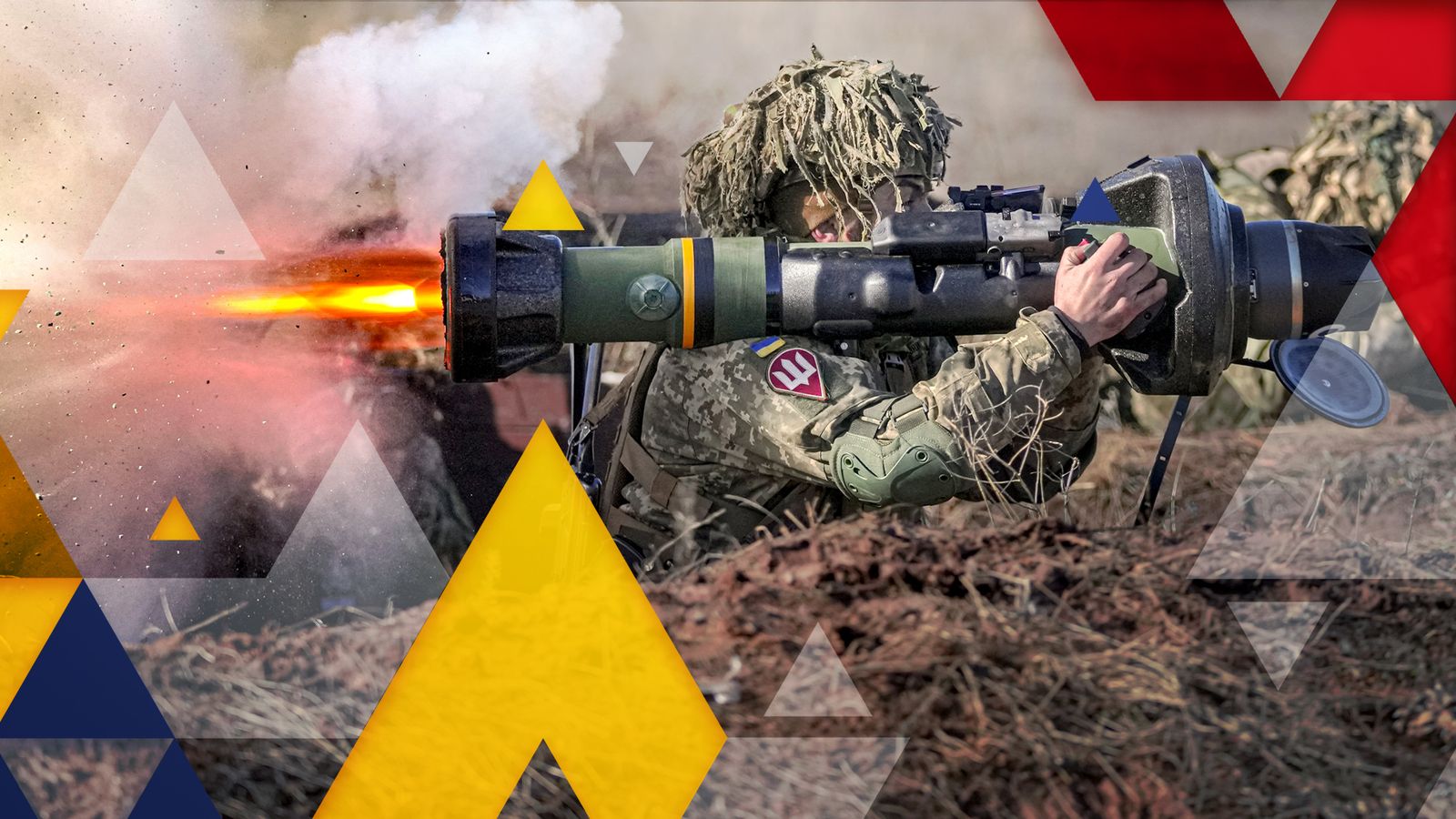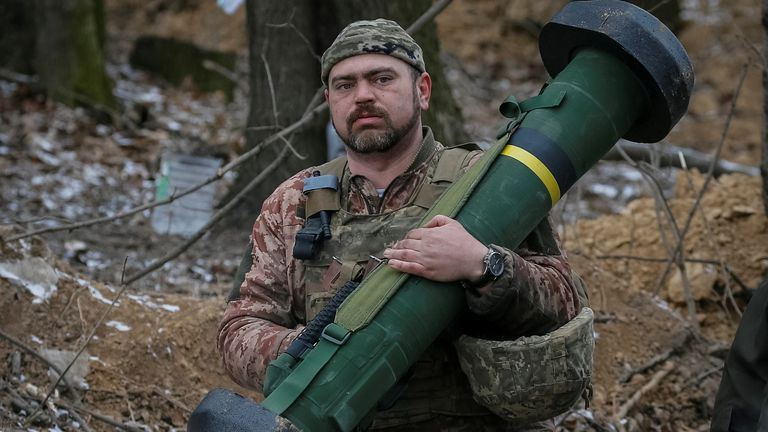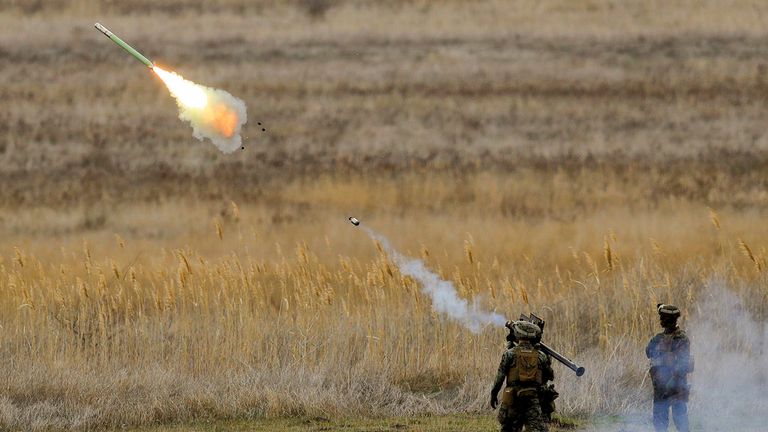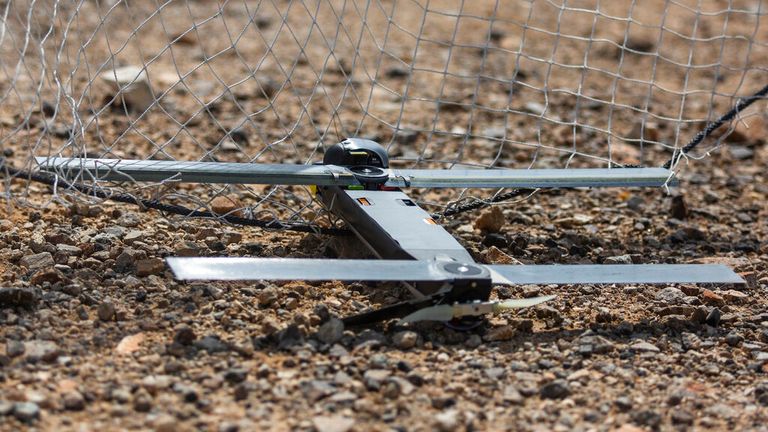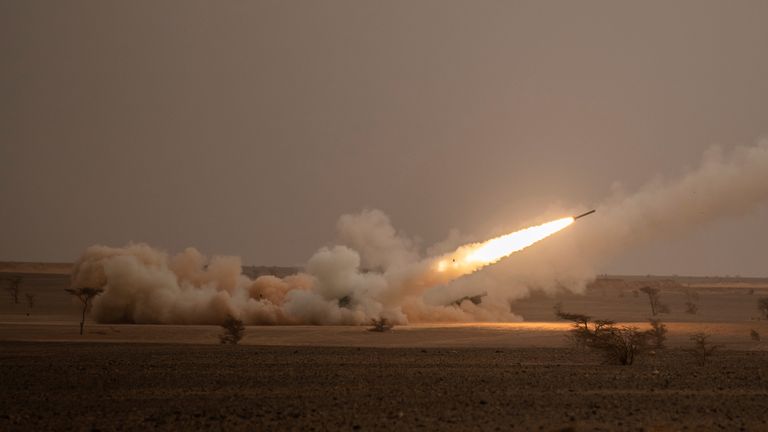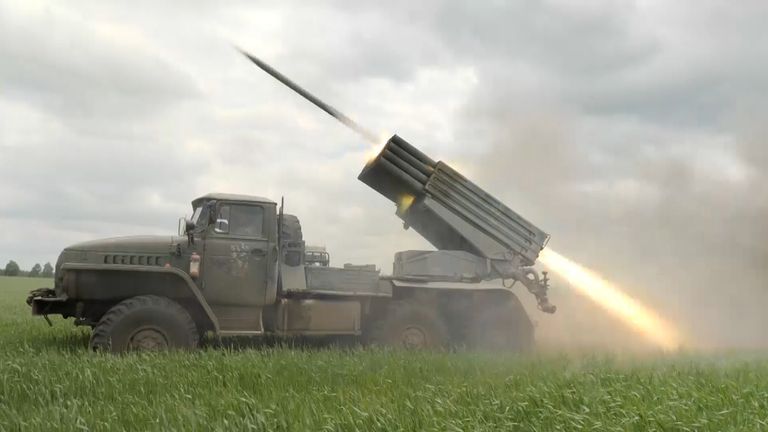The war in Ukraine has prompted Western leaders to send the country military equipment worth billions of dollars.
Experts say this, combined with the conflict’s role in pushing up military spending, will lead to a windfall for Western arms manufacturers – but there are risks.
Since the invasion, NATO countries have committed more than $8bn (£6.4bn) in military equipment for Ukraine, with $4.6bn (£3.7bn) coming from the US.
The UK has pledged £750m, while the EU has allocated €2bn (£1.7m).
Siemon Wezeman, a senior researcher at the arms transfers programme at the Stockholm International Peace Research Institute (SIPRI), says most of the weapons being sent to Ukraine are from existing military supplies.
Some countries have sent older items that were “on the way out already” – but many, like the US and UK, have sent newer stocks that will need to be replaced, he told Sky News.
The US has already approved a $9bn (£7.1bn) spending package to replenish supplies sent to Ukraine now and in the future.
Which companies will make the most money?
US defence contractors are expected to be the biggest beneficiaries.
Washington is sending 6,500 Javelin anti-tank missile systems, which are made by Raytheon and Lockheed Martin. The cost of each missile is about $78,000 (£66,000) and the reusable launcher is another $100,000 (£85,000). Ukraine will receive more of the systems from France and Estonia, with another 200 coming from the UK.
The US is also donating counter-artillery radar systems made by the same companies, along with American defence giant Northrop Grumman.
Another boon for Raytheon will come from the US decision to send 1,400 Stinger anti-aircraft missile launchers. The company has already been awarded a $625m (£494m) contract to replenish the stocks. Germany is giving Ukraine 500 of the systems and more are coming from Denmark, Italy, Latvia, Lithuania and the Netherlands.
More good news for Lockheed Martin came from the US plan to give Ukraine four M142 High Mobility Artillery Rocket Systems (HIMARS). The company also produces the long-range M270 rocket launchers being sent by the UK.
Another key item is the Switchblade aerial system made by the AeroVironment, known colloquially as a “kamikaze drone”. The US has pledged 700 of them.
Ukraine is receiving 50bn rounds of ammunition from the US, which is likely to benefit Olin, the US army’s largest small-arms ammunitions supplier.
Key winners in Europe
In Europe, the big winners are expected to include BAE Systems and Thales.
Britain’s BAE Systems manufactures nearly all of the UK’s small-arms ammunition and is set to replace the 400,000 rounds sent to Ukraine.
The company also makes the 108 155mm howitzer artillery cannons sent by the US, as well as the MILAN anti-tank guided missiles provided by France and Italy, which are produced in a joint venture with Airbus and Leonardo.
Another key piece of equipment manufactured by BAE Systems, which has factories across the UK, is the Stormer armoured vehicle. The UK is providing Ukraine with a “small number” of them.
The vehicles are equipped with Starstreak anti-aircraft missiles, which are made in Britain by Thales, a French company.
Thales also manufactures the Next Generation Light Anti-Tank Weapon (NLAW), a shoulder-launched missile system lauded for its success in blowing up Russian tanks. The UK is giving Ukraine more than 5,000 of them. Assembled in Belfast, these are believed to cost £30,000.
Germany’s Dynamit Nobel makes the 3,000 Panzerfaust 3 anti-tank weapons being sent by its home country, along with 5,100 MATADOR anti-tank weapons. Prior to the war in Ukraine, Germany had a long tradition of banning weapons exports to active warzones, which limited sales.
Large defence companies are already seeing their share prices go up as investors anticipate the impact of the war on profits. Thales shares have risen by 35% since the invasion, while BAE Systems shares are up 32%. Lockheed Martin has seen an increase of 14% and AeroVironment 63%.
Weapons ‘could end up in the wrong hands’
Kristen Bayes, a spokesperson for the Campaign Against the Arms Trade, says the provision of weapons to Ukraine is understandable but “not problem-free”.
“You might think you’re handing over weapons to people you know and like, but then they get sold on to people you absolutely don’t,” she tells Sky News.
Mr Wezeman says weapons supplied to Ukraine “may end up disappearing into the black market” – an increased risk given that the country “isn’t in full control of its territory”.
He says it is difficult to keep track of weapons when they have to be supplied at such speed and there is a risk of them getting “lost or disappearing in the chaos”.
He says there is little that can be done about this now but as soon as the war ends, a good programme needs to be put in place to collect weapons from civilians.
The US defence secretary, Lloyd Austin, has previously acknowledged that some weapons given to Ukraine have also been ending up in the hands of Russians.
Advertising opportunities and increases in military spending
Replenishing stocks sent to Ukraine is not the only new business opportunity for Western arms manufacturers.
Mr Wezeman says countries that traditionally buy a lot of military equipment from Russia may look elsewhere due to how poorly some of the same products have performed in Ukraine.
“There are Russian tanks that have been blown up completely,” he says. “That is not really an advertisement for their quality.”
He says countries also face increased pressure and sanctions threats from Western states urging them to stop buying from Russia.
He says there’s even more money to be made as states respond to the war in Ukraine by increasing their military spending – a lot of which will be used for new equipment.
Since the invasion, at least 15 European countries have announced plans for increased defence spending, according to the International Institute for Strategic Studies.
The additional commitments are worth at least €200bn (£170bn), according to the EU.
The most significant was Germany’s pledge to spend an extra €100bn (£85bn) in the coming years, with Chancellor Olaf Scholz saying defence would make up 2% of GDP “from now on”.
This has been good news for Rheinmetall, a German maker of tanks and artillery, which is expecting its sales to grow by up to 25% in 2022 and 2023. Germany has already said it will buy 35 F-35 fighter jets, which are made by Lockheed Martin and have an estimated lifetime cost of $1.6 trillion (£1.27 trillion).
Norway plans to spend an extra three billion Norwegian kroner (£270m) for border defence this year, while Latvia is set to increase its defence budget from 2.2% of GDP to 2.5% in 2023.
Finland announced an additional €700m (£600m) for this year, as well as an extra €2.2bn (£1.9bn) for 2023 to 2026.
Poland has increased military spending to 3% of GDP in 2023, up from 2.2% this year.
French President Emmanuel Macron pledged to expand his country’s defence budget, while uplifts to Estonia and Lithuania’s budgets have been announced for this year.
Italy is considering upping its military spending by €1.5bn (£1.3bn) in 2022, with the longer-term goal of raising spending to 2% of GDP from 1.4% currently.
Sweden pledged an increase of about three billion Swedish kronor (£244m) this year, while Denmark committed to a shift from 1.4% of GDP to 2% by 2033.
The UK government had already planned increases before the war – but is still facing calls from Labour to spend more. Britain already has the world’s fourth-largest defence budget, which makes up 2% of GDP.
‘Many uplifts within the next few years’
After a NATO summit on 24 March, the alliance said its members “have decided to accelerate our efforts to fulfil our commitment to the Defence Investment Pledge in its entirety”.
The Defence Investment Pledge, adopted by NATO in 2014, called for all members to stop cuts to defence budgets and meet the NATO-agreed guideline of spending at least 2% of GDP on defence within a decade – but some countries had resisted the shift.
Fenella McGerty, senior fellow for defence economics at the International Institute for Strategic Studies, says the statement in March “implies many uplifts will be within the next few years”.
“Some commitments are more concrete or immediate than others but the fact that these announcements come at the end of a period of quite remarkable growth in European defence spending is indicative of the shift in security dynamics,” she tells Sky News.
Trevor Taylor, an expert in defence management at the Royal United Services Institute (RUSI) think tank, says countries are responding to the “sense of threat”.
“You’ve got a case where Russia has demonstrated a readiness to use force to change the territorial status quo,” he tells Sky News.
He adds: “The question these days is whether Russia would try to take over smaller parts of Europe – whether that’s part of Estonia, or Latvia, whether or that’s some kind of incursion towards Poland and so on.
“Those possibilities now seem much more real than they did before the Ukrainian attack.
“I think many countries will conclude that they need to spend more on defence to try and deter those things and be able to deal with them if they occur.”
Is extra military spending necessary?
Mr Wezeman says some countries have still not made it clear how increases in military spending will be paid for, whether it’s through increased taxes or cuts from other parts of their budgets.
“The fear is always that if you’re going to spend on the military, you have to take the money away from somewhere else,” he says.
Mr Wezeman points out that as a combined group, NATO countries in Europe have already spent much more on defence than Russia for the whole period since the Cold War.
He says there are questions being asked about where such large amounts have been going and why that hasn’t been enough to deter Russia.
He says Russia may no longer be an “increased threat three years from now”, pointing to weaknesses in its economy.
The country is already spending over 4% of its GDP on its military, and Mr Wezeman says it is unlikely this would be increased further due to the economic drawbacks.
“Is Russia really the threat that we make it out, that you need to spend an enormous amount of money in addition to what you already spend?” he says. “It seems to be a little bit of a shock reaction. You get attacked, you kick, and the kick in this case is you just throw in lots of military spending, and big plans for new tanks and new that, but is that really necessary?”
Subscribe to the Ukraine War Diaries on Apple Podcasts, Google Podcasts, Spotify and Spreaker
Danger of nuclear war with Russia
Mr Wezeman says increases in military spending could also provoke Russia to expand its nuclear capabilities.
He says: “They may very well look at that and think: ‘We can’t compete with that. We cannot increase our spending at the same rate as NATO countries, it just doesn’t work. We have to find alternatives.’ And if you find no military alternatives, then you very quickly start looking at focusing more on nuclear weapons, because they are the rather cheap option.”
He says this could “bring down the threshold” for nuclear weapons use, adding: “It’s a highly dangerous game.”
Read more:
‘My child has gone… but he died a hero and I’m proud of him for that’
The weapons being used by Ukrainians to fight Russian forces – and the arms they are asking for
He says we have seen this in history when NATO introduced tactical nuclear weapons in the ’50s, ’60s and ’70s in response to huge numbers of Soviet tanks that were seen as a threat.
German Chancellor Olaf Scholz has also cited the danger of a nuclear war in his reluctance to supply Ukraine with heavy weapons like tanks and armoured vehicles. He has come under pressure from many including German defence company Rheinmetall, which has been pushing for permission to send more of these vehicles to Ukraine.
At a recent Catholic convention in Stuttgart, he said Germany is committed to supporting Ukraine but the war raises difficult political and ethical questions.
“Can violence be fought with violence?” he asked. “Or, as some put it: can peace only be achieved without weapons? It is clear that such questions can and must be discussed.”
